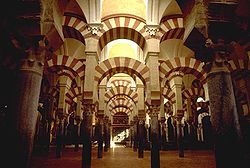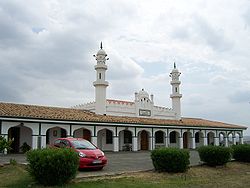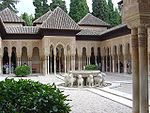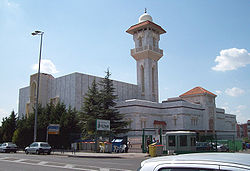- Islam in Spain
-
Part of a series on
Islam by countryThe AmericasIslam in Spain has had a fundamental presence in the culture and history of the nation. The religion was present in modern Spanish soil from 711 until 1492 under the rule of the Arabs and Moors of al-Andalus. For key historical dates, see Timeline of the Muslim presence in the Iberian peninsula. As of 2007[update], an estimated over 1 million Muslims live in Spain,[1] most of them recent immigrants from North Africa, Middle East, and South Asia; although there are also some Spanish converts, estimated at around 20,000.[2] The first Mosque after the Moors were expelled in 1492, in modern Spain, was built after approximately 500 years in 1982.[3]
Contents
History
Conquest
Hispania was the Latin name given to the whole Iberian Peninsula (covering the territories of present day Spain and Portugal), and after the fall of the Western Roman Empire (476 AD) the Teutonic tribe of Visigoths ended up ruling the whole peninsula until the Islamic conquest (during that time they pushed another Teutonic tribe out—the Vandals – and conquered another one—the Suevi). It is frequently stated in historical sources that Spain was one of the former Roman provinces where the Latin language and culture grew deep roots. After the fall of the Empire the Visigoths continued the tradition by becoming probably the most Romanized of all Teutonic tribes.
On April 30 of 711, Berber leader Tariq ibn-Ziyad landed at Gibraltar and by the end of the campaign most of the Iberian Peninsula (except for small areas in the north-west such as Asturias and the Basque territory) were brought under Islamic rule. This campaign's turning point was the battle of Guadalete, where the last Visigothic king Roderick was defeated and killed on the battlefield. After this eight year campaign, Muslim forces attempted to move north-east across the Pyrenees Mountains toward France, but were defeated by the Frankish Catholic Charles Martel at the Battle of Tours in 732.
It is commonly held that the relative ease that the Arab/Berber armies conquered the Iberian Peninsula with was due to the centralized nature of government under the rule of the Visigoths. After the defeat of Roderick, the Visigoth dominion over the Iberian peninsula folded and fell apart from the Northern coast of Spain, and the province of Septimania (an area of France going from the Pyrenees to Provence), all areas previously under the rule of the Visigoths were under Islamic rule.
Several historical sources state that the Islamic caliphate had not actually targeted Spain for conquest, but that political divisions within the Visigothic kingdom created an opportunity that Tariq and his army exploited successfully. For example, King Roderick was not considered a legitimate ruler by all the inhabitants of the Kingdom, and some Visigothic nobles actually aided the Islamic conquest. One name frequently mentioned is Count Julian of Ceuta in North Africa (this version calls him a Gothic noble), who according to some stories invited Tariq to invade because his daughter had been raped by King Roderick. Other sources instead consider Count Julian to be the last representative of the Byzantine Empire in North Africa.
Islamic rule in the Iberian peninsula lasted for varying periods ranging from only 28 years in the extreme northwest (Galicia) to 781 years in the area surrounding the city of Granada in the southeast.
Rule
History of Al-Andalus
711–1492711–732 Muslim conquest
- Battles : Battle of Guadalete
Battle of Toulouse | Battle of Tours
756–1031 Omayyads of Córdoba
1009–1106 First Taifa period
1085–1145 Almoravid rule
- Almoravid conquest
- Battle of Sagrajas
1140-1203 Second Taifa period
1147–1238 Almohad rule
1232–1287 Third Taifa period
1238–1492 Emirate of Granada
connected articles - Map of Al-Andalus
- Reconquista
The majority of the Army as well as commander Tariq himself were not Arab but Islamic Berbers, and in time Islamic migrants from places as diverse as North Africa to Yemen and Syria came to live in the Iberian peninsula. The Islamic rulers called the Iberian peninsula "Al-Andalus", which some say means "Paradise."[who?] That was the root for the name of the present-day region of Andalusia, the southernmost region of Spain.
For a time, the area that is today Spain and Portugal was one of the great Muslim civilizations, reaching its summit with the Umayyad Caliphate in the 10th century. Muslim Spain had the following chronological phases:
- The Emirate directly dependent on the Caliph in Damascus (711–756)
- The Independent Emirate (756-929)
- The Caliphate of Córdoba (929-1031)
- The first Taifas (1031-c. 1091)
- The Almoravid rule (c.1091-c. 1145)
- The second Taifas (c.1145-c. 1151)
- The Almohad rule (c.1031–1212)
- The Kingdom of Granada (1212–1492)
- The late Alpujarras revolt (1568–1571), with two monarchs appointed successively by the Morisco rebels (Note: the dates when the different taifa kingdoms were annexed by Almoravids and Almohads vary)
The status of Christians and Jews who lived in Spain during the period of Islamic rule has been a subject of controversy. Islamic religious doctrine from the onset clearly state that other monotheistic faiths had to be tolerated. In this period of history, tolerance was rare and invaders normally expelled or murdered existing populations without question[citation needed]. Even though some Islamic rulers did not always follow the dictates of their own religion, there is plenty of evidence[which?] to prove that overall the majority in the Iberian peninsula did so, the strongest is the persistence of large Jewish and Christian communities throughout the era of Islamic rule.
The Islamic rulers imposed restrictions on building new churches and synagogues, and there was discrimination regarding giving evidence against Muslims in judicial proceedings[citation needed]. In addition, the Christian and Jewish population had to pay a special tax, and non-Muslim males were not subject to military service. There was a brief period of Christian persecution in the 8th century.[4] Regardless, compared to the treatment of minorities in European kingdoms during that time period, the Muslims were generally much more tolerant[citation needed]. It was only by the end of the fourth century after Tariq's conquest that a majority of the population practiced Islam (including descendants of Visigoths and Romans).
The Madrasah of Granada was the first university in Granada, Andalusia. It was founded by the Nasrid dynasty monarch Yusuf I, Sultan of Granada in 1349.[5]
Reconquista
After the disintegration of the Caliphate, Islamic control of Spain was gradually eroded by the Spanish Reconquista. The Reconquista (Reconquest) was the process by which the Catholic Kingdoms of northern Spain eventually managed to succeed in defeating and conquering the southern Muslim states of the Iberian Peninsula. The first major city to fall to Catholic powers was Toledo in 1085,[6] what prompted the intervention of Almoravids. After the battle of Las Navas de Tolosa in 1212, most of Al-Andalus fell under control of the Catholic kingdoms, the only exception being the Nasrid dynasty Emirate of Granada.
The Granada War (Guerra de Granada or First Rebellion of Alpujarras) of the Reconquista began in 1482 against the Emirate of Granada. It was not until 1492 that the Emirate of Granada with city of Granada and the Alhambra and Generalife Palaces, the last remaining Muslim territory in al-Andalus, fell in the Battle of Granada to forces of the Catholic Monarchs (los Reyes Catolicos), Queen Isabella I of Castile and her husband King Ferdinand II of Aragon.[7] The conquest was accompanied by the Treaty of Granada signed by Emir Muhammad XII of Granada, allowing the Spanish crown's new Muslim subjects a large measure of religious toleration. They were also allowed the continuing use of their own language, schools, laws and customs. But the interpretation of the royal edict was largely left to the local Catholic authorities. Hernando de Talavera, the first Archbishop of Granada after its Catholic conquest, took a fairly tolerant view.
However 1492 started the monarchy's reversal of freedoms beginning with the Alhambra Decree. This continued when Archbishop Talavera was replaced by Cardinal Cisneros, who immediately organised a drive for mass forced conversions and burned thousands of texts in Arabic. Outraged by this breach of faith, in 1499 the Mudéjar rose in the Second Rebellion of Alpujarras, which only had the effect of giving Ferdinand and Isabella the excuse to revoke the promise of toleration. That same year the Muslim leaders of Granada were ordered to hand over almost all of the remaining books in Arabic, most of which were burned. Beginning in Valencia in 1502, Muslims were offered the choice of baptism or exile. The majority decided to accept the former, becoming 'New Catholics', of very great interest to the newly established Spanish Inquisition, authorised by Pope Sixtus IV in 1478.
The Morisco conversos (converts), though outwardly Catholic, continued to adhere to their old beliefs in private as crypto-Muslims in a practice known as taqiyyah or precaution, conduct allowed for by some Islamic authorities when the faithful are under duress or threat of life. Responding to a plea from his co-religionists in Spain, in 1504 the Grand Mufti of Oran issued a decree saying that Muslims may drink wine, eat pork and other forbidden things, if they were under compulsion to conform or persecution. There were good reasons for this; for abstinence from wine or pork could, and did, cause people to be denounced to the Spanish Inquisition. But no matter how closely they observed all of the correct forms, the Morisco or Little Moors, a term of disparagement, were little better than second-class citizens, tainted, it might be said, by blood rather than by actions.
Despite all of these pressures some people continued to observe Moorish forms, and practice as Muslims, well into the sixteenth century. In 1567 King Philip II finally made the use of the Arabic language illegal, and forbade the Islamic religion, dress, and customs, a step which led to the Second Rebellion of Alpujarras and the Morisco Revolt. This was suppressed with considerable brutality. In one incident, troops commanded by Don John of Austria destroyed the town of Galera east of Granada, after slaughtering the entire population. The Moriscos of Granada were rounded up and dispersed across Spain. 'Edicts of Expulsion' for the expulsion of the Moriscos were finally issued by Philip III in 1609 against the remaining Muslims in Spain, who by that time were concentrated in the Kingdom of Aragon in the north, and areas around Valencia where they made up 33% of the population. The corresponding expulsion of Muslims from the Kingdom of Castille was officially completed in 1614, although it is believed that up to 10,000 Moriscos remained in Spain.
The decline in revenue, and loss of technical skills, from the expulsion of Muslims from Aragon precipitated the downfall of Aragon, and the prominence of Castille – a reality which remains until today. Further, the loss of revenue and skills from Valencia lead to a shift of Catalan power from Valencia, to regions around Barcelona, which had far fewer Muslims and were thus less-affected. Present day cultural survivals of Islamic influence in Spain and Portugal include expressions such as Spanish "ojalá" and Portuguese "oxalá", meaning "may God will it" or "I hope" which is a close adaptation from an Arabic equivalent "inshallah" evoking Allah.
Recent immigration and conversion
In recent decades, immigration has resulted in a resurgence in the presence of Islam, with over one million Muslims currently residing in Spain, of which the majority are Moroccans and Spaniards represented by the Islamic Commission of Spain. Many Muslims include those from other neighboring African countries (Mostly Morocco), Syrians, Lebanese, Iraqis, Iranians, and few a Bengali's, Indians, and Pakistanis.
There are a number of converts to Islam, estimated at around 20,000 from a total number of one million muslims.[2] Many converts to Islam reside in the southern Andalusia region and have opened Muslim learning centers drawing visitors from across Europe, Canada and the United States.[8]
Notes
- ^ "Muslims in Europe: Country guide See also: Spain"]. BBC. 2005-12-23. http://news.bbc.co.uk/2/hi/europe/4385768.stm#spain. Retrieved 2010-05-05.
- ^ a b In Spain, dismay at Muslim converts holding sway
- ^ "Who are Ahmadi?". BBC. 2010-05-28. http://news.bbc.co.uk/1/hi/8711026.stm. Retrieved 2011-01-09.
- ^ "Christian Martyrs in Muslim Spain - Master Page". http://libro.uca.edu/martyrs/martyrs.htm. Retrieved 2008-08-13.
- ^ La Madraza, alhambra.org. Accessed online 2010-01-23.
- ^ "BBC - Religion & Ethics - Muslim Spain (711-1492): Decline and fall". http://www.bbc.co.uk/religion/religions/islam/history/spain_5.shtml. Retrieved 2008-08-13.
- ^ "The City of Granada, Andalusia, Southern Spain". http://www.andalucia.com/cities/granada.htm. Retrieved 2008-08-13.
- ^ Inside Muslim summer camp in southern Spain
External links
- "Spain: Bishop Rejects Muslim Prayers in Cathedral." Agence France-Presse at The New York Times. 29 December 2006.
- Nash, Elizabeth. "Spanish bishops fear rebirth of Islamic kingdom." The Independent. Friday 5 January 2007.
- Islam en linea
Islam in Europe Sovereign
states- Albania
- Andorra
- Armenia
- Austria
- Azerbaijan
- Belarus
- Belgium
- Bosnia and Herzegovina
- Bulgaria
- Croatia
- Cyprus
- Czech Republic
- Denmark
- Estonia
- Finland
- France
- Georgia
- Germany
- Greece
- Hungary
- Iceland
- Ireland
- Italy
- Kazakhstan
- Latvia
- Liechtenstein
- Lithuania
- Luxembourg
- Macedonia
- Malta
- Moldova
- Monaco
- Montenegro
- Netherlands
- Norway
- Poland
- Portugal
- Romania
- Russia
- San Marino
- Serbia
- Slovakia
- Slovenia
- Spain
- Sweden
- Switzerland
- Turkey
- Ukraine
- United Kingdom
- (England
- Northern Ireland
- Scotland
- Wales)
- Vatican City
States with limited
recognition- Abkhazia
- Kosovo
- Nagorno-Karabakh
- Northern Cyprus
- South Ossetia
- Transnistria
Dependencies
and other territories- Åland
- Faroe Islands
- Gibraltar
- Guernsey
- Jan Mayen
- Jersey
- Isle of Man
- Svalbard
Other entities Categories:- Islam in Spain
- Muslim dynasties
- Former empires
- Al-Andalus
- Battles : Battle of Guadalete
Wikimedia Foundation. 2010.





